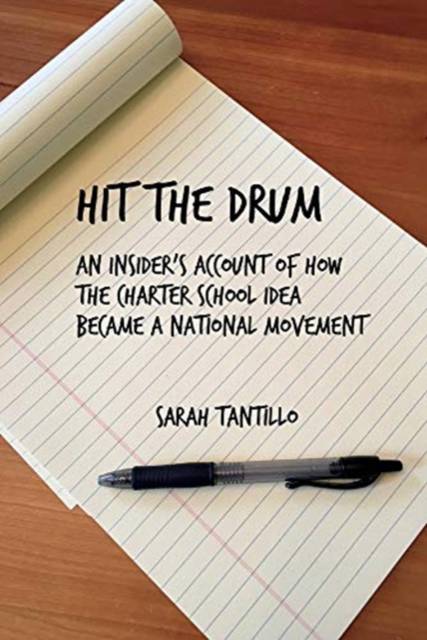
- Afhalen na 1 uur in een winkel met voorraad
- Gratis thuislevering in België vanaf € 30
- Ruim aanbod met 7 miljoen producten
- Afhalen na 1 uur in een winkel met voorraad
- Gratis thuislevering in België vanaf € 30
- Ruim aanbod met 7 miljoen producten
Zoeken
Hit the Drum
An Insider's Account of How the Charter School Idea Became a National Movement Volume 1
Sarah Tantillo
Paperback | Engels
€ 27,95
+ 55 punten
Omschrijving
The first state charter school law was passed in Minnesota in 1991. The idea that teachers, parents, and other community members could launch these independent public schools of choice proceeded to spread rapidly across the country. Within two decades, many charter schools had long waiting lists and parents willing to march on their behalf. By 2017, more than 6,900 charter schools were operating in 44 states plus DC, serving 3.2 million children. In spite of the controversy that often swirls around them, charter schools have dropped strong roots into the field of education. HIT THE DRUM is a page-turning narrative that gives an insider's perspective to explain how this transformation happened. It tells the engaging stories of several dozen unsung heroes and heroines--many of them classroom teachers--who decided to change their lives in order to join this grassroots movement which has dramatically altered the landscape of public education in America. If you are interested in education reform or how social movements grow and spread--or if you want to understand more about why we have the kinds of schools we do and how schools might look in the future--this book is a must-read.TABLE OF CONTENTSINTRODUCTIONPART I: FIRST STEPSChapter 1: Seeing What's Possible: Day One at North Star AcademyChapter 2: A Nation at Risk and Time for ResultsChapter 3: Where Did the Idea of Chartering Come From?Chapter 4: Preparing the Field and Planting the SeedsChapter 5: California and Michigan and the Early ChallengesChapter 6: "All Choice Is Good and More Choice Is Better" Two WarriorsChapter 7: The PioneerChapter 8: "Who's Going to Help People Start These Things?"Chapter 9: "We Had Nothing to Lose"Chapter 10: From Small Schools to Charter Schools in ChicagoChapter 11: How to Make the Most of a Crisis: The DC StoryChapter 12: A Pot of Meatballs Among FriendsChapter 13: Herding Cats, Part IPART II: SCALING UP: QUANTITY VS. QUALITYChapter 14: Explaining This New ThingChapter 15: Why Aren't All Charter Schools Great?Chapter 16: "Weeding Is Hard Work"Chapter 17: The Superintendent and the EntrepreneurChapter 18: A Couple of RookiesChapter 19: KIPP and YES PrepChapter 20: The Disgruntled Graduate StudentChapter 21: Building the Uncommon TeamChapter 22: "From Margins to Mainstream" Chapter 23: "How Many Schools Can You Open?"Chapter 24: Herding Cats, Part II, and the Double-edged Sword of PhilanthropyChapter 25: The Katrina EffectChapter 26: "Don't Steal Possible"PART III: ROOTS TAKING HOLDChapter 27: The Promise of "R & D" Labs vs. The RealityChapter 28: Using Data DifferentlyChapter 29: Changing How Teachers and Leaders Are Prepared, Part IChapter 30: Changing How Teachers and Leaders Are Prepared, Part IICONCLUSION: Why Charters Have Not FadedACKNOWLEDGMENTSNOTE ON METHODOLOGYABOUT THE AUTHORNOTES
Specificaties
Betrokkenen
- Auteur(s):
- Uitgeverij:
Inhoud
- Aantal bladzijden:
- 340
- Taal:
- Engels
Eigenschappen
- Productcode (EAN):
- 9781543967449
- Verschijningsdatum:
- 3/06/2019
- Uitvoering:
- Paperback
- Formaat:
- Trade paperback (VS)
- Afmetingen:
- 152 mm x 226 mm
- Gewicht:
- 544 g

Alleen bij Standaard Boekhandel
+ 55 punten op je klantenkaart van Standaard Boekhandel
Beoordelingen
We publiceren alleen reviews die voldoen aan de voorwaarden voor reviews. Bekijk onze voorwaarden voor reviews.











